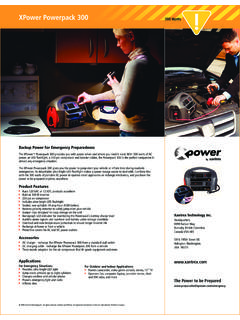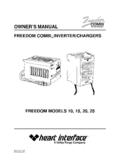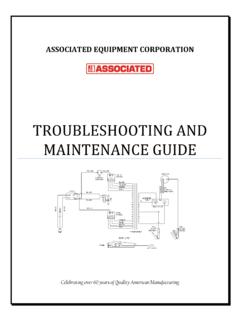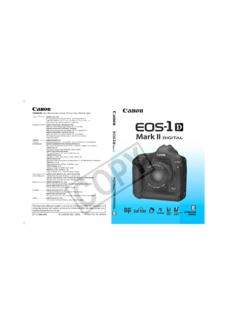Transcription of INVERTER INSTALLATION: TROUBLESHOOTING 101!
1 TMunderstand that these types of products simply don t kind-of fail. When an INVERTER goes bad, typically nothing will work .. or, one of the features simply won t work consistently. STRATEGIES FOR INVERTER installation Revert all settings to factory defaults. This may seem obvious, but the factory default settings are usually default for a reason. They are the values that allow the INVERTER to work in the vast majority of environments. While you don t want to leave these settings to factory default in the long term, for a quick test, it s ideal. After completing the test, then you can easily readjust the settings to meet your specific needs. Check the settings, one by one, until the problem is identified, or the settings are adjusted to work.
2 Note: If the INVERTER came installed with your vehicle/vessel, the manufacturer would likely have changed the factory default settings to custom settings to suit the design and application. In such circumstances, once you reset the INVERTER to the default OEM/manufacturer setting, you may not need any further changes. So you want to install an INVERTER , but with all the features and complexity of today s more sophisticated units, you re hesitant to take the plunge? Or, perhaps you ve had some problems with your INVERTER , and you re not sure if it s a faulty unit .. or a simple installation problem? Let the Tech Doctor help! This issue offers up some basic TROUBLESHOOTING tips to help ensure your INVERTER is installed correctly in order to deliver maximum, trouble-free delivery.
3 Success in this area will save aggravation and potentially money associated with having to engage a support technician for unwarranted and unnecessary repairs. LET S GET , an overview. When working with electrical circuits, you must always ensure the circuit is powered down and cannot be re-energized while you are working on it. If you re not entirely comfortable with this task (or any other cited in this article) then by all means, leave it to the experts. Your attention and compliance to all safety directives must always be first and foremost! THE BASIC BENCHMARK. If for any reason, things don t seem to be working as they should with your INVERTER , INVERTER installation : TROUBLESHOOTING 101!
4 Quick Tips to Maximize Your INVERTER s Zesty PerformanceBy Tech Doctor Don Wilson TECH DOCTOR DON WILSON has worked in technical capacities in the automotive, RV and marine fields and for the military since 1989 and has extensive experience in designing and TROUBLESHOOTING onboard electrical systems. A former customer service manager dealing with electronic issues, Wilson currently serves as a technical instructor for the RV industry s RVIA Trouble Shooter Clinics and is a full-time sales application specialist for Xantrex Technology.*Xantrex Technology provides this technical editorial for reproduction in your publication. Editorial content (other than headline) may not be edited and author byline and brief biography must be included.
5 For copies of the original Word document or an image of Don Wilson, request via e-mail Mitul Chandrani, Marketing Manager at For immediate Editorial Release and Usage* -+ TMA FINAL TROUBLESHOOTING For the most part, inverters either work, or they don t. 2. From my own experience and in working with dozens of tech service centers, I have concluded that more than 80% of inverters that are returned without hands-on TROUBLESHOOTING have absolutely no issues on the bench. The problem in at least 20 percent of the returns correlate directly to faulty installations. 3. Erratic behavior, or inconsistent problems, are almost always a loose While it s not easy to find them, it s worth the time and the effort.
6 4. A quality volt-meter is worth the investment. While there is a cost associated with ownership, it may pay off in eliminating shipping and diagnostic bench time at the service center that is unnecessary. 5. Safety first!. Power down as much as reasonable when working with circuits. Always use one hand when working with wiring. If you re not qualified, or are not 100% confident in the process you re attempting, hire a qualifed , inverters are nothing more than an appliance that does what it s told to do. If it doesn t receive the right instructions, or can t interpret its input, it likely will not perform to your expectations, through no fault of its own. Take the time to ensure the proper installation in order to maximize the performance of your hard-working INVERTER !
7 Then, you will realize its ultimate return on Disconnect all loads. This action will remove the installation as a possible cause of the problem. This is also a good time to disconnect the battery, wait a few minutes, and then reconnect, in order to reboot the INVERTER s Power up the INVERTER . If this works, bring the loads on-line, one by Watch the DC voltage at the INVERTER and make sure the voltage stays within the DC voltage range of the INVERTER . This eliminates the possibility that an ineffective circuit from the battery is causing the issue. If the voltage is erratic, solve that problem by tracing the cause of the erratic voltage and fixing it, and then get back to the INVERTER .
8 Recommendation: if you don t have a spare DC fuse on board, get one!Also, read up on and review the features of your INVERTER . Some perceived problems actually arise from features in the INVERTER like idle mode, or power save. Such features, when enabled, allow the INVERTER to turn off when the load is low, but can create the very real perception of a problem. Remember: inverters don t produce energy; they simply convert what they re given. If you have a combination INVERTER /charger, and the INVERTER doesn t work, but the charger is humming along fine, then check the DC voltage at the INVERTER when inverting to gauge whether it is within the INVERTER s DC range. If the INVERTER works, but the charger is problematic, then check the AC input voltage at the INVERTER and ensure it is within the INVERTER s AC range.
9 With a sound read of what the unit is receiving, you can eliminate most causes of perceived WELCOME YOUR QUESTIONS FOR TECH DOCTOR!If you have a topic you d like to see our Tech Doctor handle, please send us an email with your ideas and suggestions! Send your comments and feedback to back issues of Tech Doctor which are available for editorial reproduction, please visit 2013 Schneider Electric. All Rights Reserved. All trademarks are owned by Schneider Electric Industries SAS or its affiliated companies.

















